Painting Early and Mid-War Waffen-SS
Hallo zusammen und willkommen zu meinem zweiten Tutorial für die Ostfront im zweiten Weltkrieg. Dieses Mal nehmen wir uns die Waffen-SS vor mit Hauptaugenmerk auf deren Tarnkleider. Auch wenn dieser Guide für Early- und Mid-War ist, so können diese Tarnungen auch im Late-War verwendet werden. Ich muss eingestehen, dass ich viel Freude daran habe Waffen-SS zu bemalen. Ihre Tarnung sieht großartig aus (vielleicht weil sie so “bunt” ist) und es macht Spaß diese zu malen. Ich möchte, in diesem Zusammenhang, betonen, dass dieses Tutorial vollkommen dazu dient dem Spieler zu helfen eine gut aussehende und historisch akurate Figur auf das Spielfeld zu bringen. In keinster Weise möchte ich den Nationalsozialismus, die SS, deren politische Einstellung und alles was damit zu tun hat glorifizieren. Das zählt für all meine Arbeiten und Artikel hier.
Für das bevorstehende Projekt empfehle ich einen guten und feinen Pinsel. Ich empfehle den Series 7 Pinsel von Winsor and Newton, welchen ich für all meine Infanterie benutze. Größe 0 und 1 reichen vollkommen aus für 15mm.
Hello everyone and welcome to my second painting tutorial for the WW2 Eastern Front. This time we will take on the Waffen-SS, specially their camouflage patterns. You also can use these patterns in Late War. I have to admit that I love to paint Waffen-SS. Their camouflage looks great (may be because it is so colorful) and is fun to paint. I also would like to stress that this tutorial is quintessentially a guide to aid the modeller to create a good looking and historical miniature. In no way does it seek to glorify the SS, Nazi politics or practises. That counts for all my works and articles here.
For this project you need a fine and good brush and I highly recommend the Winsor and Newton Series 7 brush. I use size 0 and 1 on nearly all my 15mm infantry.
Das wohl am häufigsten vorkommende Tarnmuster für die Zeit von 1939 bis 1943 ist wohl das Platanenmuster (welches recht leich zu malen ist) gefolgt von der Palmentarnung. Diese gab es in Sommer- und Herbstausführung als wendbare Kleidung/Zeltbahn. Die Platoons sind etwas spannender anzugucken wenn diese Varianten ein wenig untereinander mischt, obwohl ich gehört hab (ganz sicher bin ich aber nicht), dass eine Mischung so gut wie nie der Fall war. Werfen wir einen genaueren Blick auf die Muster.
The most common camo-patterns for Early- and Mid-War are the easy Platanentarn (plane tree) and the Palmentarn (palm tree). A summer and autumn variant was available as reversible camouflage clothing. It makes your platoon much more interessting to look at if you mix those variants a little bit even so I heard(I am really not sure), they were never mixed. Let’s take a closer look at the patterns.
Johan Georg Otto Schick gestaltete diese Muster (in erster Linie das Platanentarn) und sie wurden 1938 als Zeltbahn, Schlupfhemd und Helmbezüge an die SS-Verfügungstruppe ausgegeben. Der Gebrauch dieser Tarnung war in erster Linie der Waffen-SS vorbehalten, obwohl es auch andere Truppengattung gab, welche diese erhalten haben wie zum Beispiel Einheiten der Luftwaffe. Das Platanentarn wurde von 1937 bis 1942 produziert, wobei ich mir sicher bin, dass einige Soldaten dieses auch bis zum Ende des Krieges trugen.
Johan Georg Otto Schick designed those patterns (at least the Platanentarn) and they were issued as Zeltbahn, smocks and helmet covers to the SS-Verfügungstruppe in 1938. The use of these were limited to the Waffen-SS even so some Luftwaffe and other units used these. The plane tree pattern was produced from 1937 to 1942 but I am sure that a lot of soldiers still used it till the end of war.
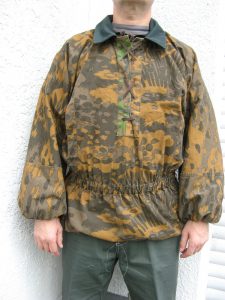
Die Palmentarnung wurd 1941 eingeführt, ebenfalls als Schlupfhemd, Zeltbahn oder Helmbezug. Leider habe ich so gut wie keine Informationen dazu, allerdings glaube ich, dass es nicht ganz so häufig anzutreffen war wie das Platanentarn. Auf dem obrigen Bild sieht man die Herbstvariante und grundlegend ähnelt es dem Platanentarn sehr. Nur hier und da kann man die Formen von Palmensträuchern/-blättern erkennen.
Beide Muster bestehen aus vier Farben, jedoch erkennt man nur drei aus der Ferne. Deswegen benutze ich auch nur diese drei Töne für die kleinen 15mm Soldaten.
The Palmentarn (palm tree) pattern was introduced in 1941 again as smock, Zeltbahn and helmet covers. I don’t have any information on this but I guess it wasn’t as common as the plane tree pattern. On the picture above you see the autumn variant and basically it looks like the Platanentarn but here and there you can see the shapes of palm leafs.
These patterns are made of four colors, however from far away you only see three colors and that’s why I just use the three obvious colors on a tiny 15 mm soldier.
Lets start painting!

 Step 00
Step 00
Wie immer grundiere ich die Figur schwarz. Die obere Figur wird das Platanentarn und die untere das Palmentarn erhalten.
Nothing new on the first step. As usual I primed the miniatures black. The upper figure will get the Platanentarn (plane tree) and the lower one the Palmentarn (palm tree).
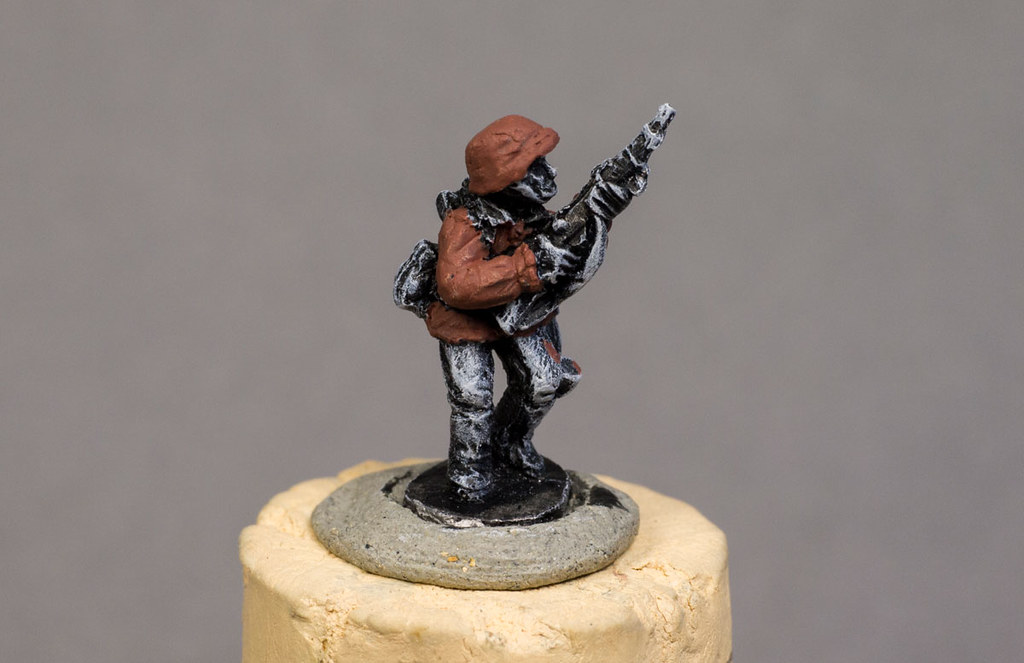
 Step 01
Step 01
Die erste Farbe für beide ist VMC Saddle Brown. Eine andere gute Farbe dafür ist VMC Beige Brown. Der Helmbezug der zweiten Figur wird die Herbstvariante erhalten.
The first color for the camo smocks is VMC Saddle Brown. Another good color choice is VMC Beige Brown for that if you don’t have Saddle Brown. The helmet cover on the second miniature will be in palm tree autumn.

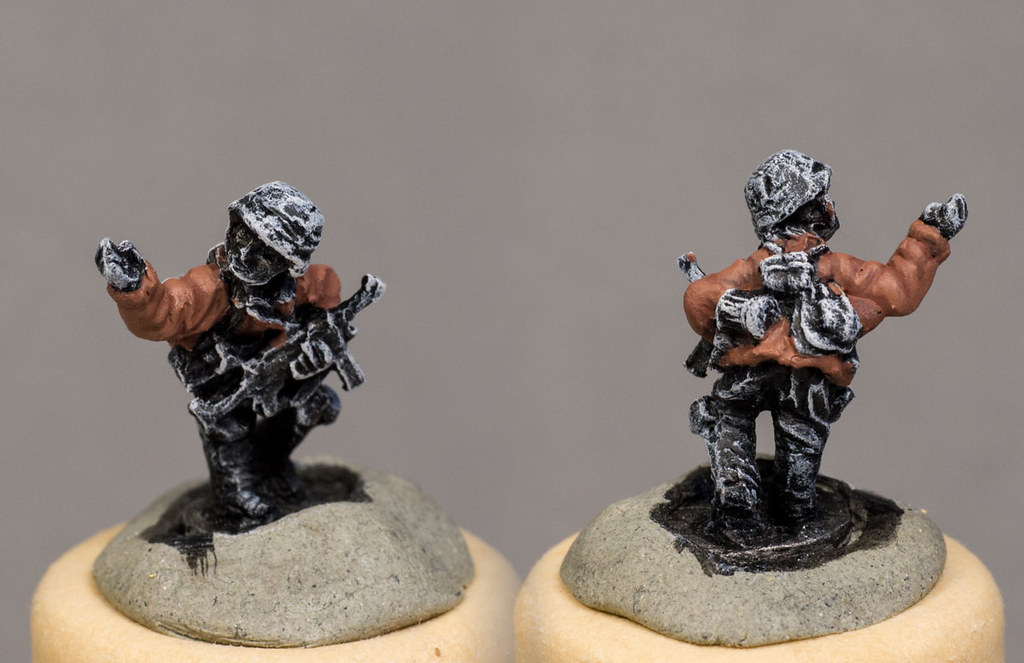 Step 02
Step 02
Ich trug ein leichtes Highlight auf indem ich ein wenig VMC Sunny Skin Tone der Grundfarbe beimischte. Man kann diese Farbe auch trockenbürsten.
I applied a light highlight by mixing some VMC Sunny Skin Tone to the base color. You also can drybrush the miniature.
Step 03
Tüpfel mit der spitze deines Pinsels kleine Punkte aus VMC Olive Green (am besten mit ein wenig Sunny Skin Tone vermischt) auf. VMC German Camo Bright Green, Golden Olive oder Medium Olive sind ebenfalls gute Farben für diesen Schritt.
Stipple with the tip of your brush small dots of VMC Olive Green (with a small drop of Sunny Skine Tone) one the smock and helmet. German Camo Bright Green, Golden Olive or Medium Olive are also good colors for that step.
Step 04 Platanentarn Summer
Erneut tüpfel Punkte aus VMC German Camo Extra Dark Green auf die Tarnkleidung. Wie man auf dem Bild am Anfang des Artikels gut sehen kann bedeckt diese Farbe die meiste Fläche des Musters, daher muss man sich nicht zurück halten. Eventuell braucht man ein paar Versuche bis man es richtig hinbekommt, aber es ist wirklich nicht so schwer wie es aussieht. Eine weitere Option wäre ein leichtes Wash danach aufzutragen, allerdings halte ich das für nicht nötig.
Again stipple dots of VMC German Camo Extra Dark Green on camouflage clothing. As you can see on the image at the beginning of the article it covers most of the pattern so you don’t have to hold back. It may be takes a few tries before you master it but it isn’t as hard as it looks like. You also can apply a light wash after that step but it isn’t necessary if you ask me.
 Step 04 Palmentarn Summer
Step 04 Palmentarn Summer
Für das Palmentarn wiederholt man das gleiche wie für das Platanentarnmuster, mit der Ausnahme, dass man hier und da dünne Striche hinzufügt. Das kann man an den Ellbogen der Figur recht gut sehen. Dieses Muster in diesem Maßstab getreu nachzustellen halte ich für schwer und für Zeitaufwendig, daher halte ich diese Art und Weise für aussreichend. Ich sah auch viele Bilder in denen das dunkle Grün wesentlich heller war. Daher kann man optional auch ein anderes Grün verwenden zum Beispiel VMC German Camo Dark Green oder man mischt sein eigenes.
Basically you do the same as for the Platanentarn except that you add a few thin lines of dark green here and there as you might see on the elbows of the miniature. Recreating the palm tree pattern at that scale is really hard and would take too much time so this is enough if you ask me. I saw a lot of pictures of that camo where the dark green areas are brighter. That is also an option which means you can use another dark green like German Camo Dark Green or you mix your own.
 Step 05 Palmentarn Herbst/Autumn
Step 05 Palmentarn Herbst/Autumn
Das Grundbraun der Herbstvariante ist ein wenig anders als die Sommerausführung. Für den Helmbezug mischte ich also VMC Beige Brown und VMC Khaki (1:1) zusammen. ANdere Farboptionen sind VMC German Camo Pale Brown, VMC Cork Brown, eine Mischung aus VMC Chocolate Brown und VMC Khaki oder, mein persönlicher Favorit, VMC German Camo Medium Brown und VMC Khaki. Wenn man im Internet recherchiert findet man viele verschiedene Brauntöne dafür, daher macht man wirklich nichts falsch wenn man sich einen der obrigen aussucht.
The base brown of the autumn variant is a bit different as for the summer one. For this helmet cover I mixed VMC Beige Brown and VMC Khaki (1:1) together and applied it to it. Other colors would be VMC German Camo Pale Brown, VMC Cork Brown or a mixture of VMC Chocolate Brown and VMC Khaki or VMC German Camo Medium Brown and VMC Khaki. The last one is my personal favourite. If you take a look on the internet you will find a lot of different browns for that so you are not doing anything wrong if you take one of the above.
 Step 06 Palmentarn Herbst/Autumn
Step 06 Palmentarn Herbst/Autumn
Wir wiederholen die Schritte aus Step 03 allerdings mit VMC Yellow Ochre. Andere Optionen sind VMC Ochre Brown, VMC Orange Brown, VMC German Camo Orange Ochre oder eine Mischung aus VMC German Camo Orange Ochre und VMC Orange Brown.
We repeat the step from step 03 but we use VMC Yellow Ochre. Other options are VMC Ochre Brown, VMC Orange Brown, VMC German Camo Orange Ochre or a mixture of VMC German Camo Orange Ochre and VMC Orange Brown.
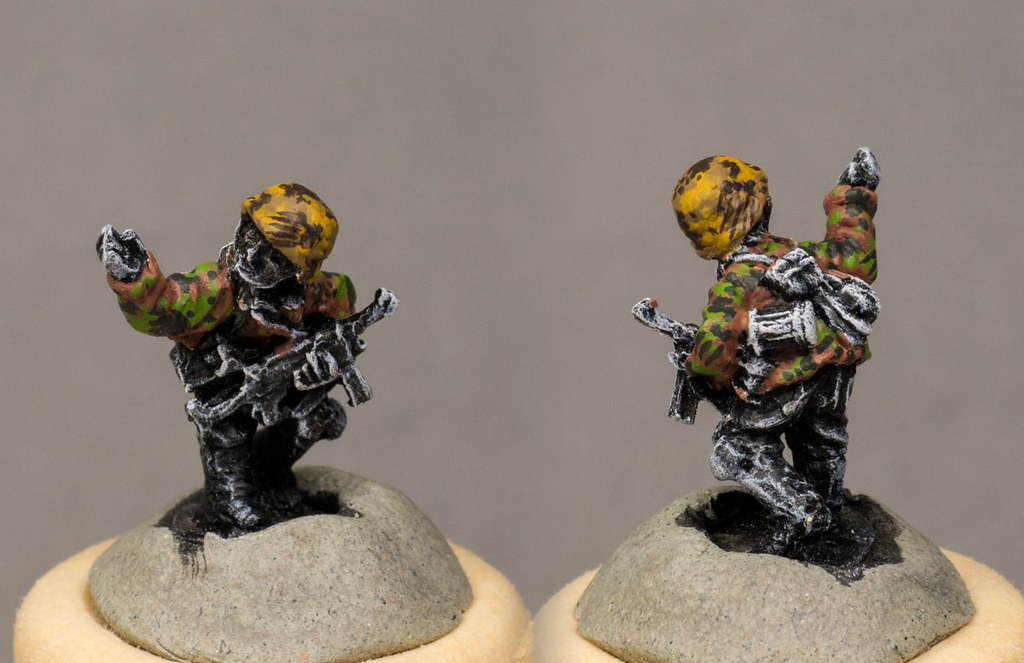 Step 07 Palmentarn Herbst/Autumn
Step 07 Palmentarn Herbst/Autumn
Die Anweisungen aus Step 04 wurden mit VMC German Camo Black Brown wiederholt. Natürlich kann man auch das selbe mit dem Platanentarn machen indem man die Sommer- durch die Herbstfarben tauscht.
Repeat the instructions from step 04 Palmentarn summer with VMC German Camo Black Brown. You can do the same with the plane tree pattern but altering the summer colors to the autumn colors.
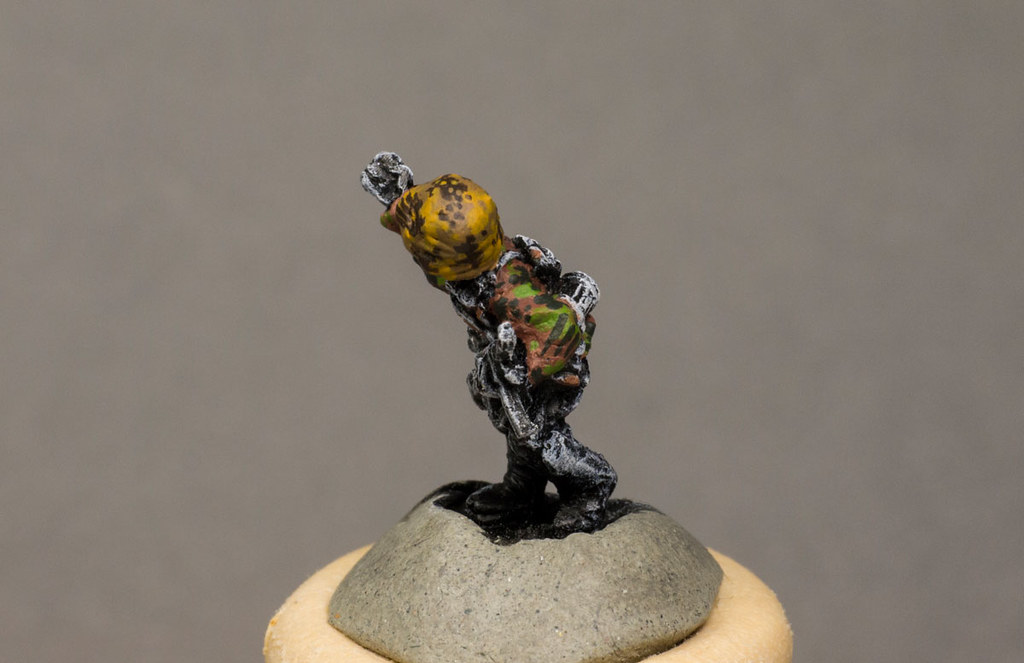 Step 08 Palmentarn Herbst/Autumn
Step 08 Palmentarn Herbst/Autumn
Für mehr Details und näher an das original heranzukommen, kann man noch Punkte aus VMC Yellow Ochre und dem Grundbraun in die dunkelbraunen Flecken machen. Das kann man hier am oberen Helm sehen. Natürlich gilt das gleiche auch für das Platanentarn.
To get more details and to get closer to the original pattern you can add some Yellow Ochre and base brown dots on the black brown areas like on the top of that helmet here. Same counts for the plane tree pattern.
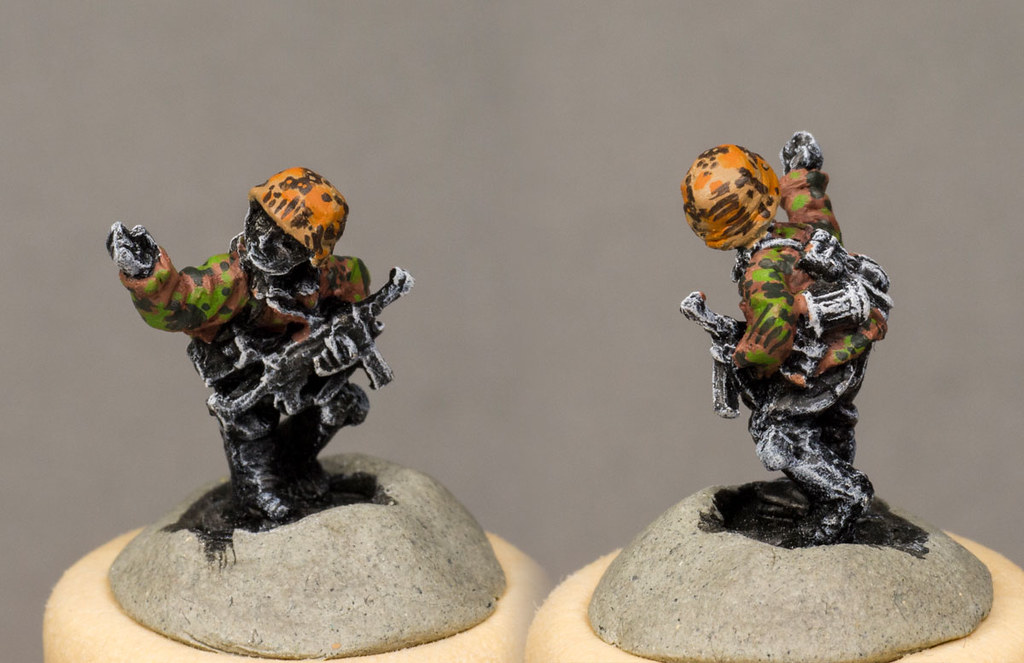 Step 08 Palmentarn Herbst/Autumn
Step 08 Palmentarn Herbst/Autumn
Hier ist eine Alternative mit VMC Cork Brown und VMC Orange Brown.
Here you can see an alternate edition with VMC Cork Brown and VMC Orange Brown.
 Step 09
Step 09
Die Hosen wurden mit einer Mischung aus Schwarz und VMC German Fieldgrey (1:1) bemalt.
The trousers were painted with a mixture of Black and VMC German Fieldgrey (1:1).
Step 10
Dann wurde VMC Fieldgrey aufgetragen. Dabei wurden die Vertiefungen in der Schattenfarbe gelassen.
Then pure VMC Fieldgrey was applied. Leave some of the shadow color showing as shader in the recesses.
Step 11
Für die Akzentuierung wurde VMC Green Grey zu Fieldgrey gemischt.
Highlight the trousers by adding VMC Green Grey to Fieldgrey.
Step 12
Die Haut wurde wie üblich bemalt. Schattenfarbe war VMC Beige Brown. Für die Grundfarbe wurde VMC Flat Flesh beigefügt. Das erste Highlight war reines VMC Flat Flesh. Mit etwas Weiß dazu wurde ein zweites Highlight auf die erhöhten Stellen gemalt (Nasenspitze und Wangen).
Paint the Skin as usual. Shadow color is VMC Beige Brown. Add some VMC Flat Flesh to it for the base color. The first highlight will be pure VMC Flat Flesh. With some white added to it you get a second highlight for the raised parts of the face (Nosetip or cheeks).
Step 13
Das Gewehr, die Stiefel und all die andere Ausrüstung wurden schwarz grundiert.
Paint the rifle, the boots and all the other equipment black.
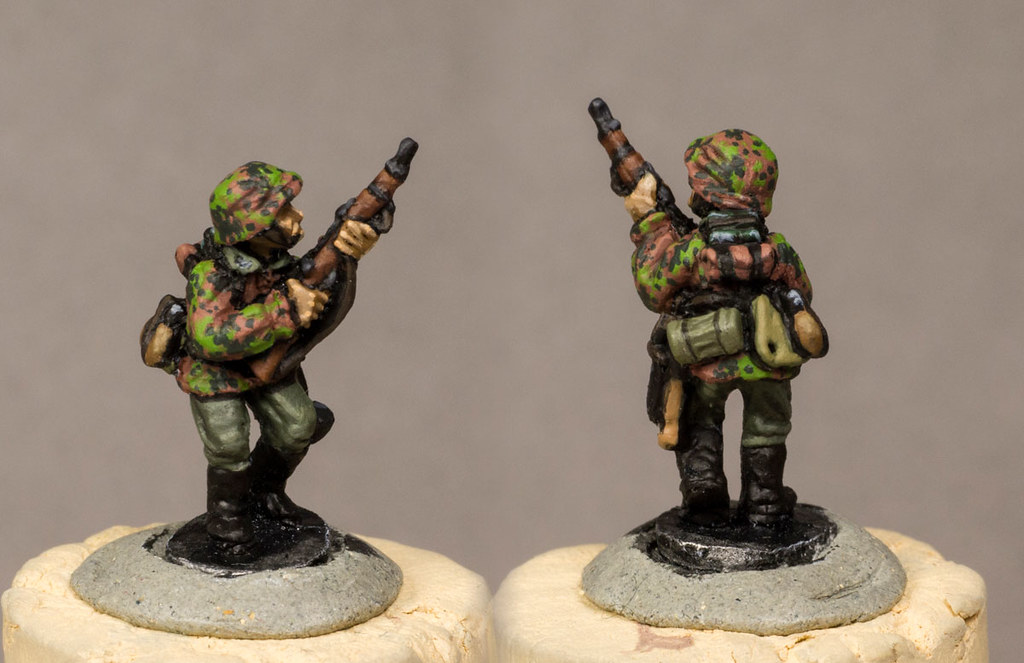
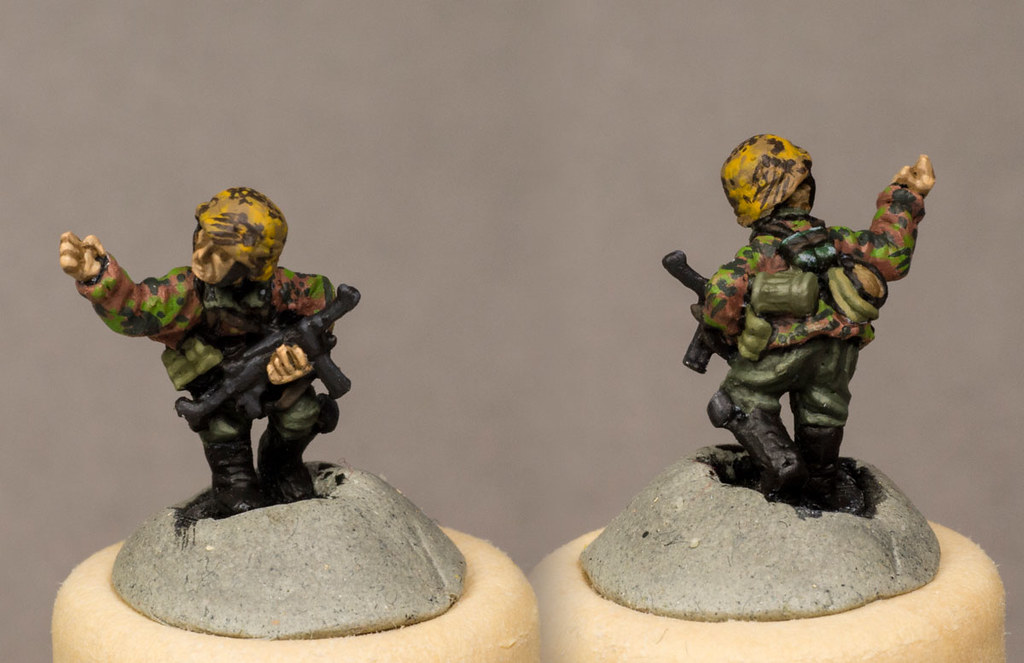 Step 14
Step 14
Um die Sache etwas abzukürzen und weil ich in einem Tutorial darauf nochmal eingehen werden, gehe ich in einem Schritt die Ausrüstung durch: Das Gewehr wurde in VMC Flat Brown bemalt und danach, durch Beifügen von VMC Light Brown, gehighlighted. Die Metallteile wurden schwarz bemalt und mit einem dunklen Grau akzentuiert. Mische dafür Schwarz und ein wenig Beige zusammen. Die Zeltbahn auf dem Rücken wurde mit VMC Saddle Brown bemalt und VMC Sunny Skin Tone, welches ich zur Grundfarbe mischte, akzentuiert. Die Grundfarbe für den Gasmaskenkanister ist VMC Brown Violet. VMC Green Grey wurde für das Highlight hinzugemischt. Alternativ kann man auch VMC Russian Uniform oder VMC German Fieldgrey als Grundfarbe nehmen. VMC Russian Uniform ist übrigens die Grundfarbe für die Brottasche und die MP40 Magazintaschen. Diese wurden mit VMC Khaki gehighlighted. Trageriemen und Gürtel wurden mit VMC German Camo Black Brown bemalt. Leather Brown ist eine Alternative dazu. Für den Holzschaft des Spaten benutzte iche VMC Cork Brown. Die Wasserflasche bekam eine Grundierung mit VMC Beige Brown und eine Akzentuierung durch das Beimischen von Beige. Das Kochgeschirr wurde mit Military Green bemalt. Man kann es auch schwarz lassen, Dunkelgrau, Russian Uniform oder German Fieldgrey bemalen. Ich simulierte den Lackschaden auf dem Kochgeschirr und dem Trinkbecher der Wasserflasche in dem ich VMC Light Grey drauftüpfelte. Natrürlich kann man auch Weiß oder Silber dafür verwenden. Danach wurde noch die Figur mit VGC Black Ink geblacklined (für diese Tätigkeit fällt mir einfach kein deutsches Wort ein)
To make short things short (and I will talk about all that in another tutorial): Paint the rifle with VMC Flat Brown and highlight it by mixing VMC Light Brown to the base color. The metal parts were painted black and highlighted with a dark grey mixture of black and beige. The Zeltbahn on the back was painted VMC Saddle Brown and highlighted by adding VMC Sunny Skin Tone. Base color for the gas mask canister was VMC Brown Violet and VMC Green Grey was added for the highlight. You also can use Fieldgrey or Russian Uniform as basecolor. VMC Russian Uniform was the basecolor for the breadbag and the MP40 pouches. VMC Khaki was used as highlight color. Straps and the rifle sling were painted with VMC German Camo Black Brown. I applied pure Cork Brown on the wooden part of the shovel. The water bottle got VMC Beige Brown as base color and beige was added for the highlight. The mess tin was painted VMC Military green. You can also leave it black or a dark grey. I added some damage to the mess tin and the canteen cup of the watter bottle with VMC Light Grey (or you use White or silver).
After all that I black lined the figures with VGC Black Ink.
 Step 15
Step 15
Wenn man möchte kann man noch Kragenspiegel auf die Figuren malen. Dieser Soldat ist nun SS-Unterscharführer.
If you love to you can paint some collar tabs on the miniatures. This guy is now a SS-Unterscharführer.
Vielen Dank fürs lesen und ich hoffe dieses Tutorial war euch eine Hilfe. Es werden auf jeden Fall noch zwei weiter Guides folgen zum Einen über Deutsche Panzer und zum Anderen über reguläre Wehrmachts Truppen.
Thank you for reading and I hope this was helpful for you. Stay tuned for following guides about painting German tanks and Wehrmacht.
Anbei noch eine Liste der verwendeten Farben:
Here is a list of the used colors:
Summer Variant
VMC Saddle Brown (940)
VMC Sunny Skin Tone (845)
VMC Olive Green (967)
VMC German Camo Extra Dark Green (896)
Autumn Variant
VMC Beige Brown (875)
VMC Khaki (988)
VMC Yellow Ochre (913)
VMC German Camo Black Brown (822)
Uniform
Black
VMC Fieldgrey (830)
VMC Green Grey (886)
Equipment and Rifle
VMC Flat Brown (984)
VMC Light Brown (929)
VMC Brown Violet (887)
VMC Russian Uniform (924)
VMC Military Green (975)
VMC Light Grey (990)
VGC Black Ink (054)
Skin
VMC Flat Flesh (955)
White
VMC = Vallejo Model Color
VGC = Vallejo Game Color

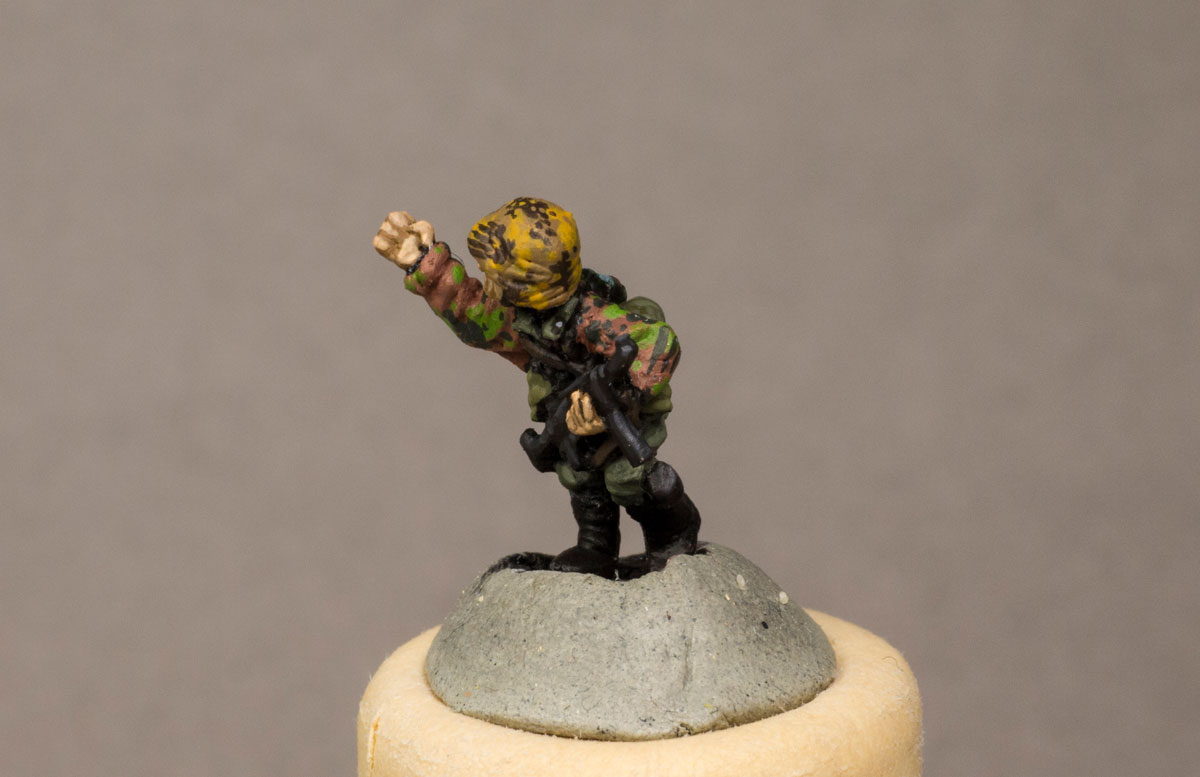
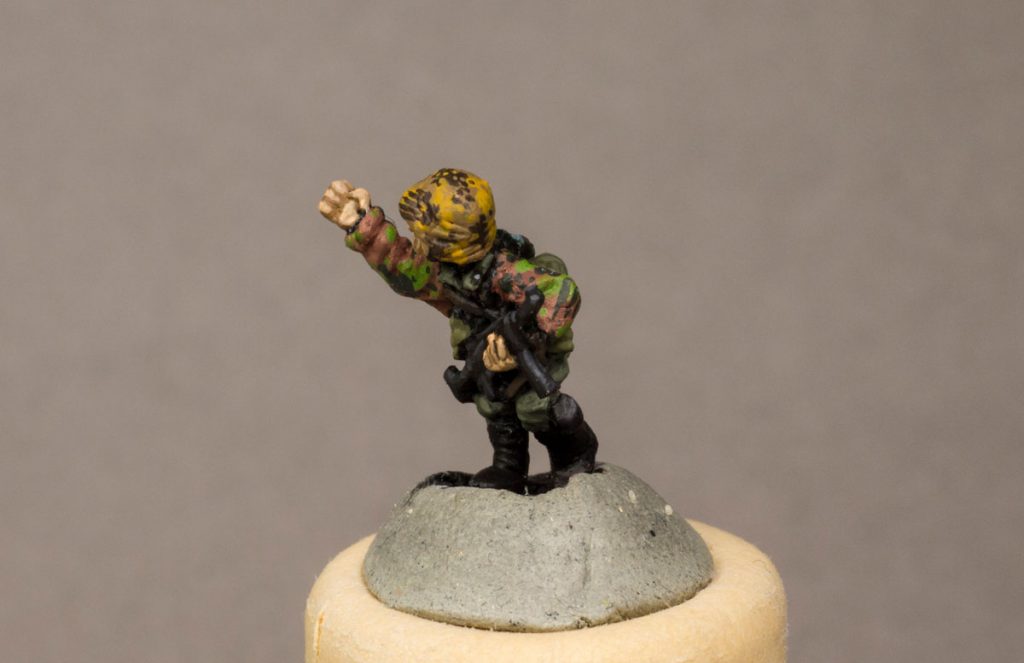
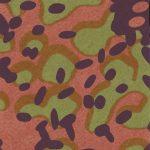
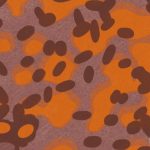
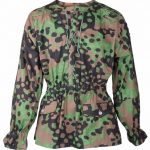
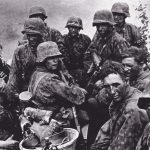
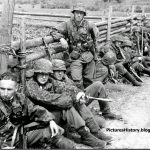
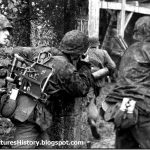
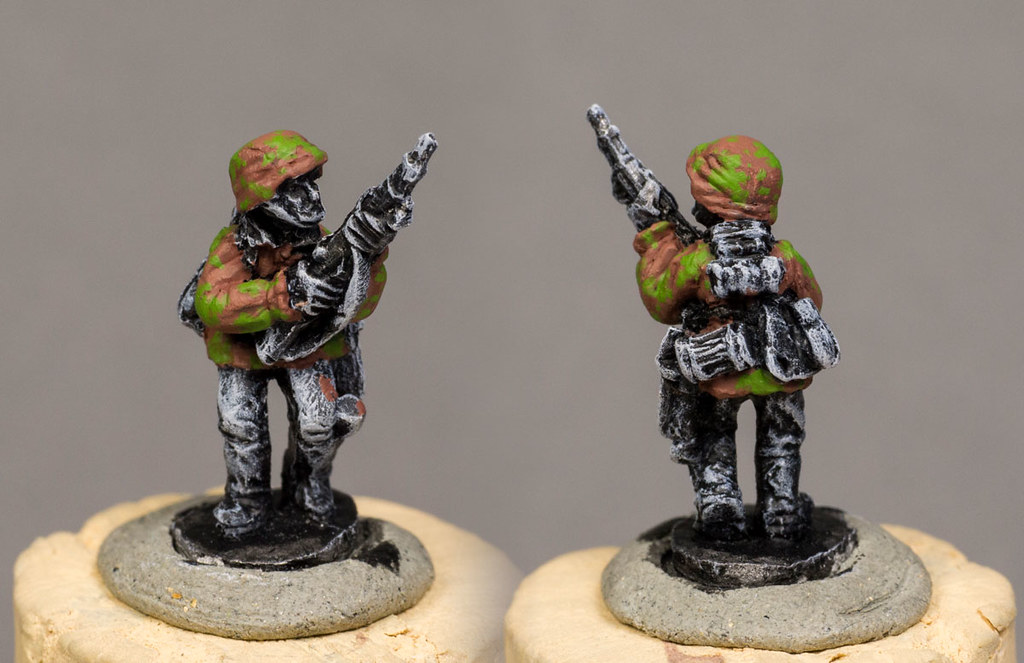
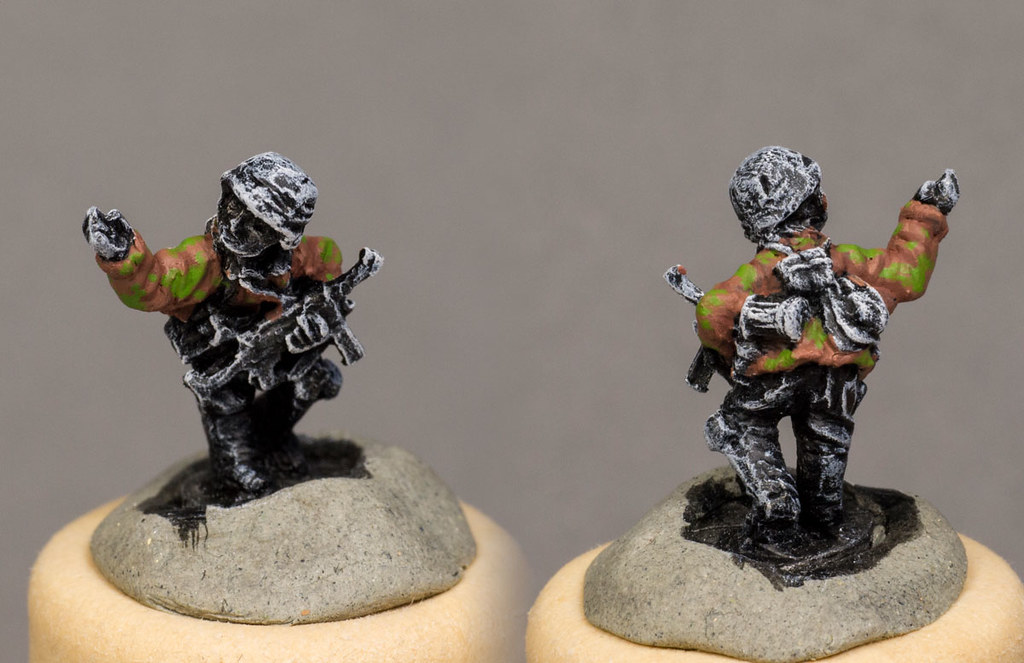
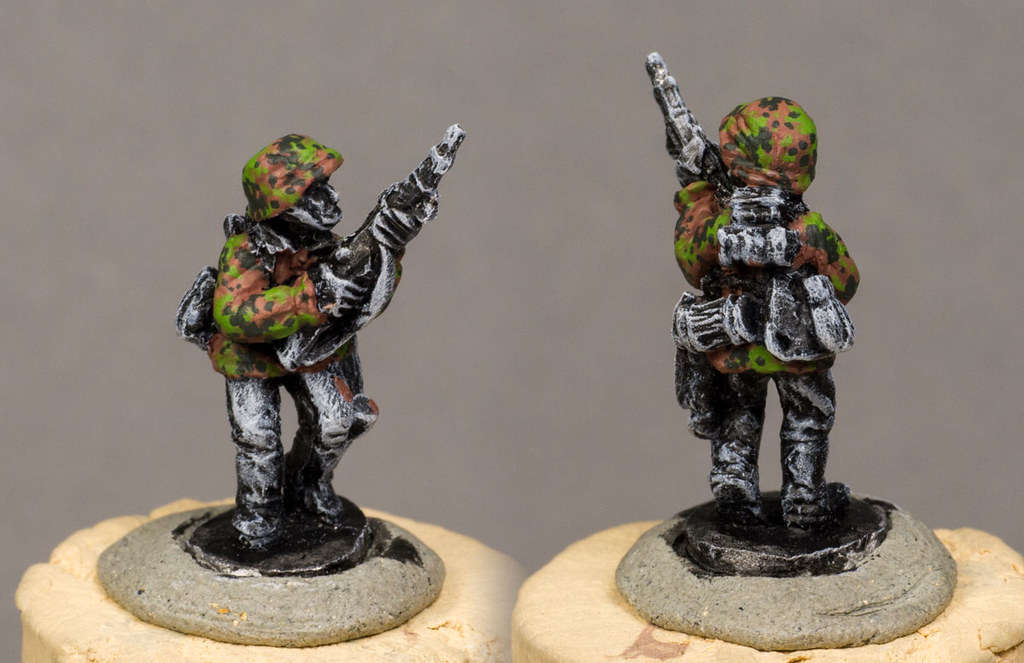
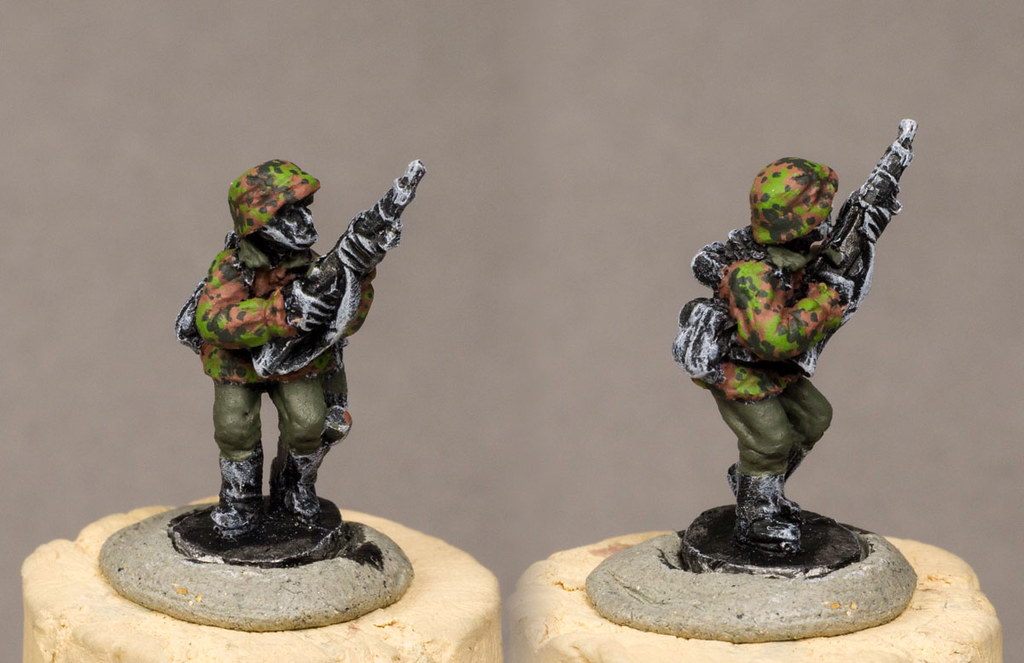
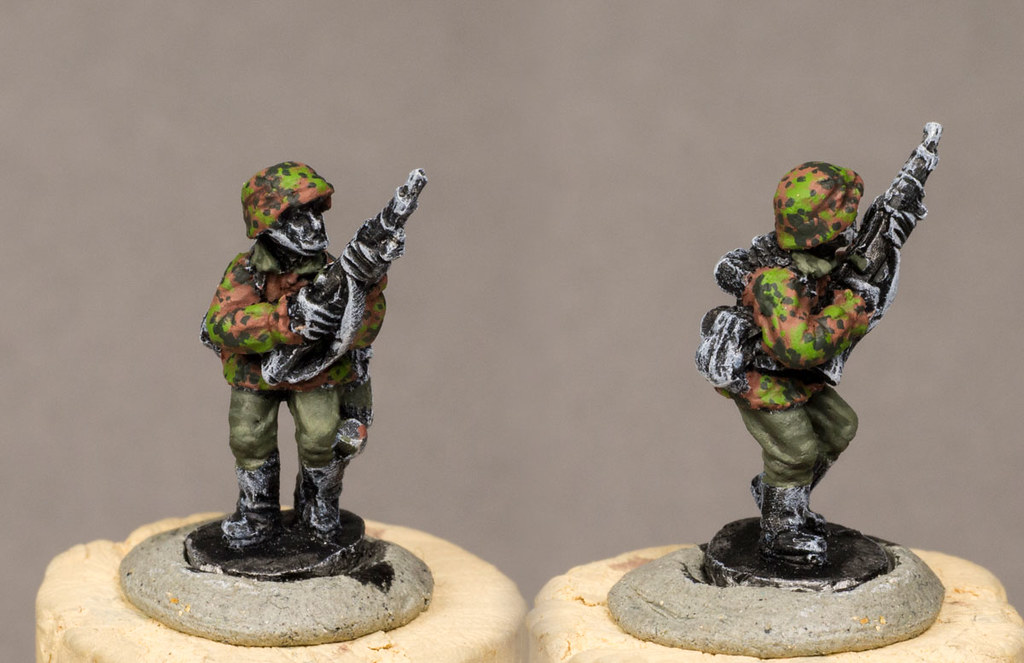
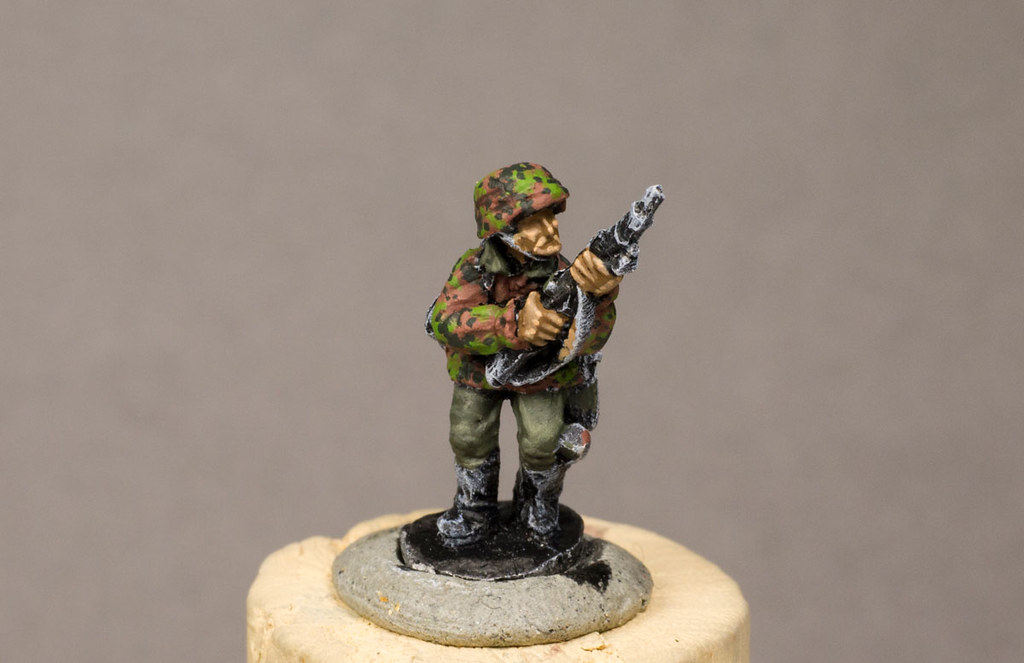
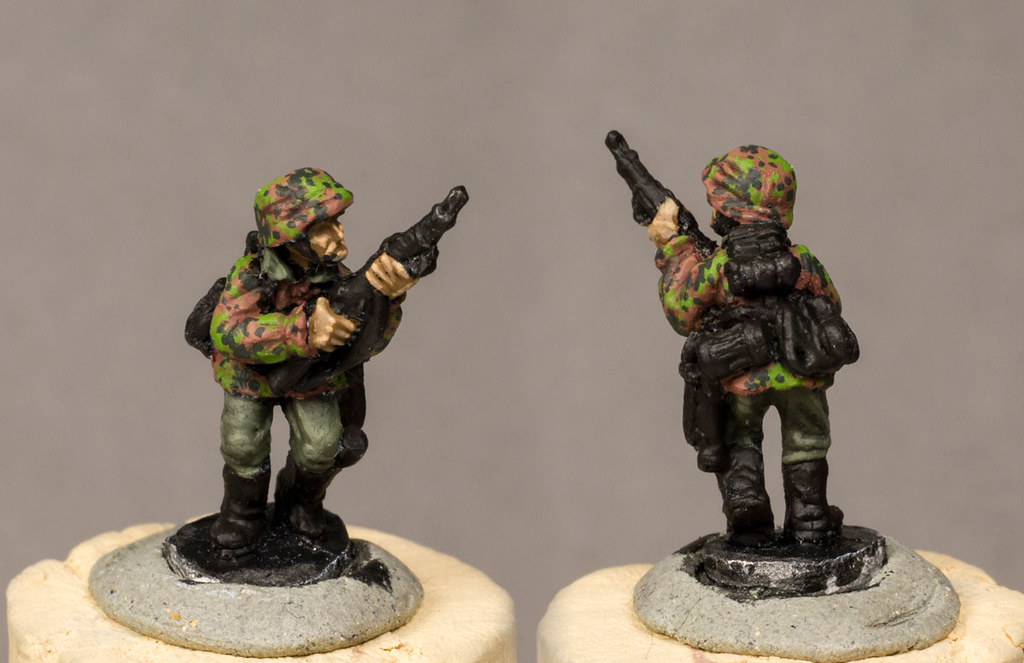
Really thorough tutorial! Your minis look superb and I appreciate you sharing technique. Thankyou. I have some crudely painted SS but will try to match yours for the same excellent effects in my late war infantry – still have a few ( loads ) to paint!
Great tutorial. Lovely looking minis with lots of contrast to really make those 15mm models pop on the gaming table. Thanks for all the work you put into this fine article.
Thanks.